Report

The missing link
Gender equality won’t be achieved without significant male engagement.
Corporate Australia remains far from reaching gender parity, so concerted action is still required to balance the scales. Given their predominance in leadership positions, men’s support is critical to achieving gender equality.
In the past year, the proportion of female CEOs in ASX 200 companies went up from 5% to 7%, bringing the total number to 14. That’s important progress. But every step toward equality requires significant effort, rallied by a small base. Most parity programmes are run by women, for women. Meanwhile, executive meetings are overwhelmingly male. The issue of gender parity must become gender equal itself if we are to effect change.
Research tells us that men show less support for gender equality initiatives than women. Why are they less engaged? Some men simply are just not interested in the issue or don’t want to advance gender equality. But those men are the minority. In fact, most men are engaged or want to be. Our research brings additional data to the discussion to propose actionable recommendations to increase the overall engagement of men and dispel myths.
There’s good reason to increase female representation across the workforce. Gender parity has been proven, across geographies and sectors, to positively affect business outcomes. Organisations with greater diversity have greater retention, higher levels of employee advocacy, overall better performance and faster growth—to name just a few of the documented benefits.
And corporate actions can make a difference. When gender equality is treated as a strategic priority, with top-down support and a data-driven approach to setting aspirations and developing programmes, the makeup of the boardroom and executive teams can change. Even in male-dominated industries such as mining, in which the workforce can be about 80% male, companies that commit to diversity are finding gender parity within their reach.
Previous research established which initiatives have the greatest influence on equality: Visible and committed leadership, more broadly available flexible working models, removing bias from people processes and normalising an inclusive culture are all key to meaningful progress (see Figure 1). Across these actions, leadership drive and engagement are essential (see “Take action, and celebrate progress: Case study”). From the top down, support for gender equality must be openly committed to, communicated about and acted upon (see the Bain Report What stops women from reaching the top? Confronting the tough issues).
Leadership drive and engagement is an essential enabler for the four most effective initiatives
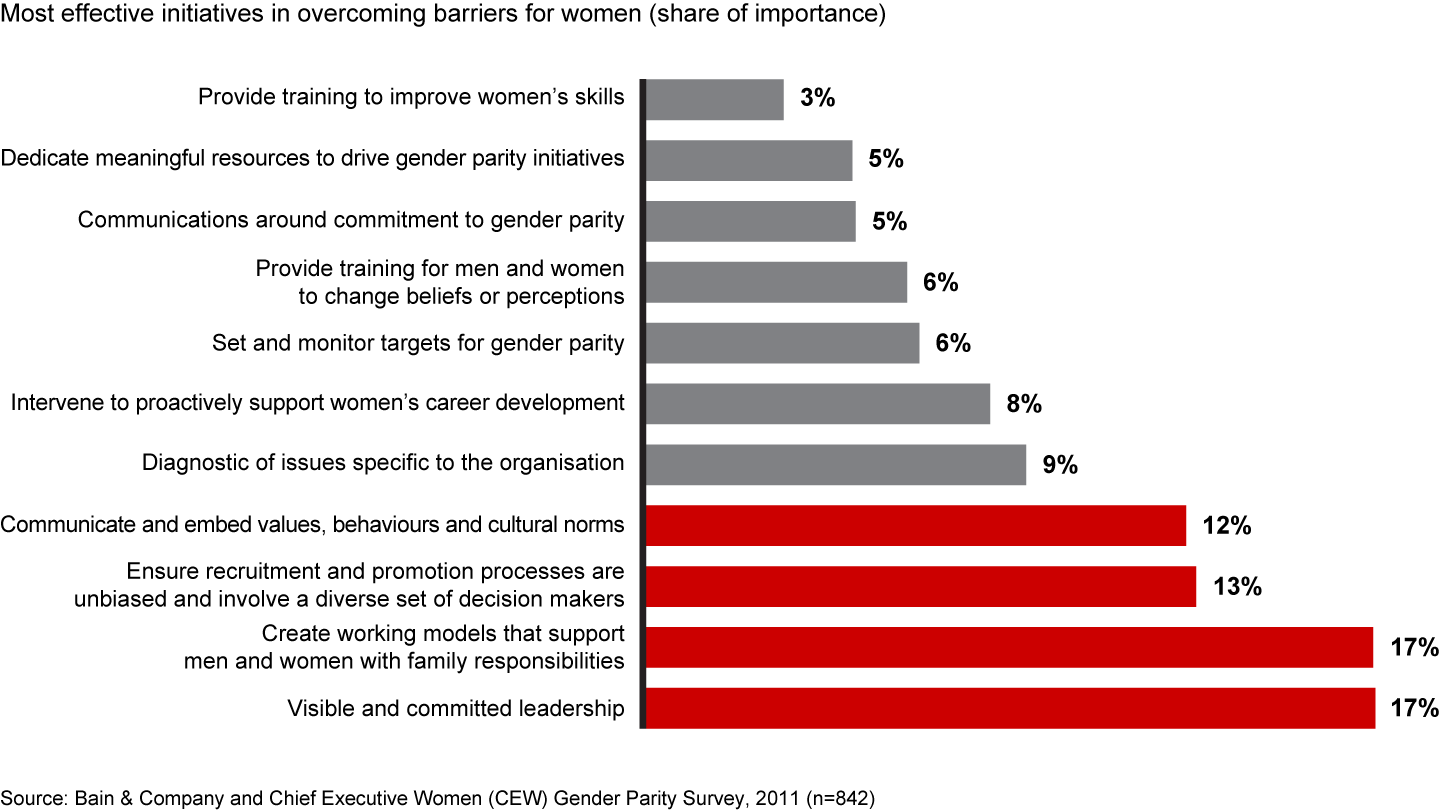
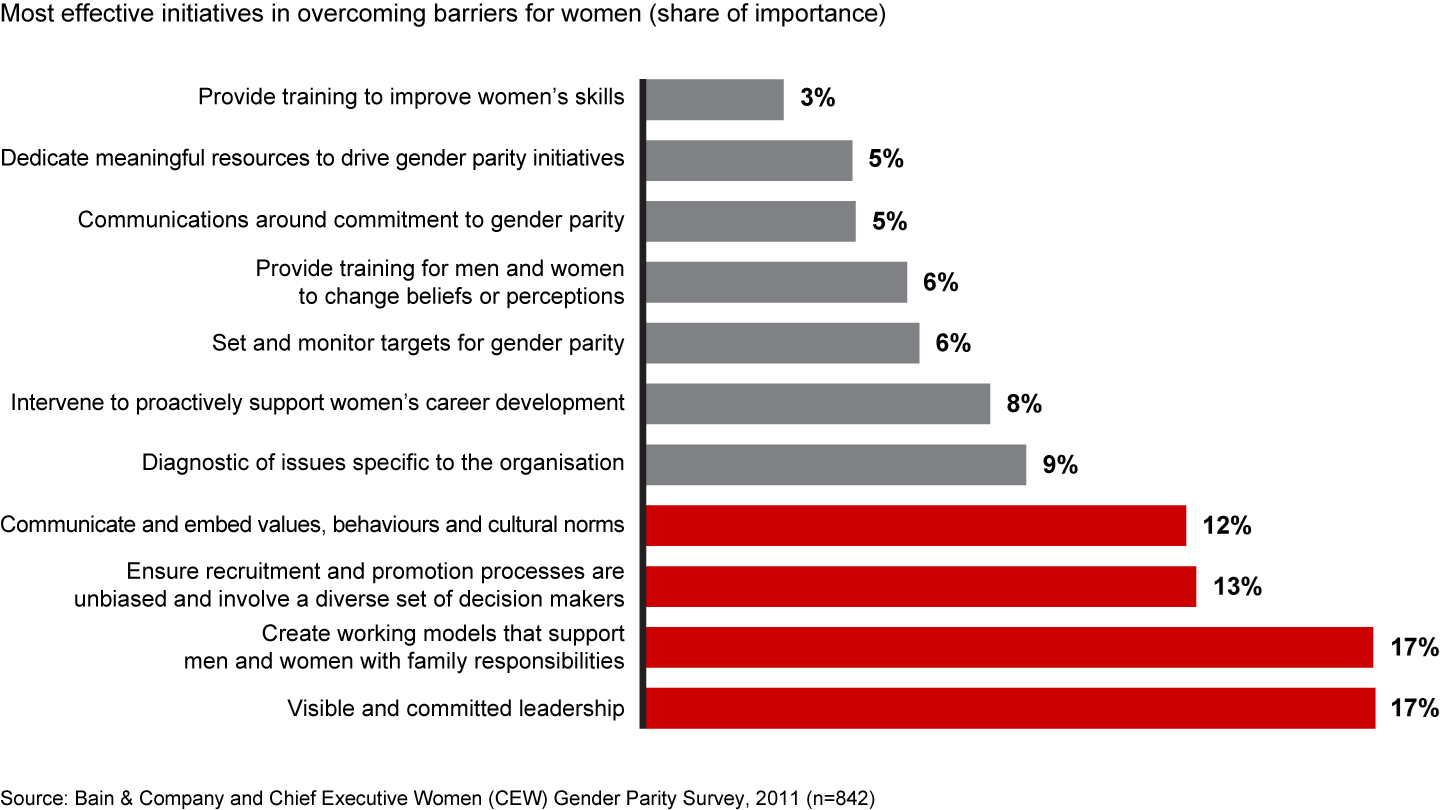
Given their majority in leadership, it is critical to ensure that men have an equal stake in gender parity.
-
Take action, and celebrate progress: Case study (click to expand)
In 2016, BHP, the world’s largest mining group, announced plans to support greater balance in the gender mix of its workforce by 2025. At the time, the company had a base of 17% women.
The announcement was followed by action. BHP added inclusive language to its charter, redesigned tasks to remove gender and demographic biases, and expanded apprentice programmes that encourage women and indigenous people to apply. Flexible working options were created for all employees, and formal sponsorship programmes were developed for women. In every department, in every mine, in every location—action was taken to make sure that language and behaviour became intentionally inclusive.
Two years into its initiative, BHP is focusing on a sustained effort to meet its aspirational targets over time. And BHP’s most diverse and inclusive teams exceed the company average on a range of performance metrics: They have lower injury rates and better adherence to work plans and production targets.
Male engagement today
So, how engaged are men in gender equality efforts in Australia? Beyond counting attendance at gender equality meetings, measuring engagement is not easy. To benchmark their engagement, we asked men about their participation and role in activities that support or enable gender diversity. Based on their responses, we established levels of engagement.
From our overall sample, we determined that 13% of men are not engaged in gender diversity initiatives at all, while 17% of men report being highly engaged. The majority of men sit in the benign middle, neither highly engaged nor fully disengaged (see Figure 2).
17% of male respondents are highly engaged in gender equality activities
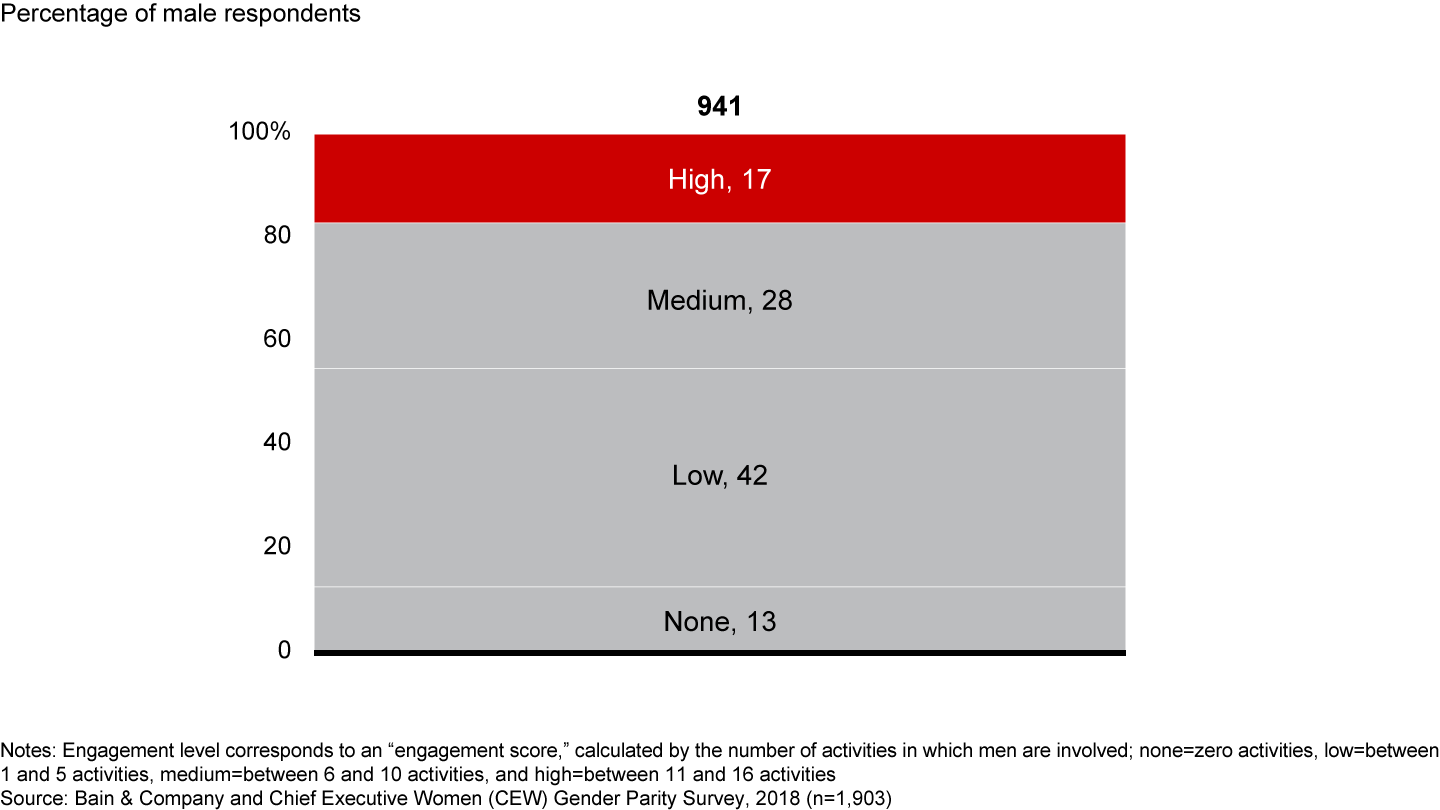
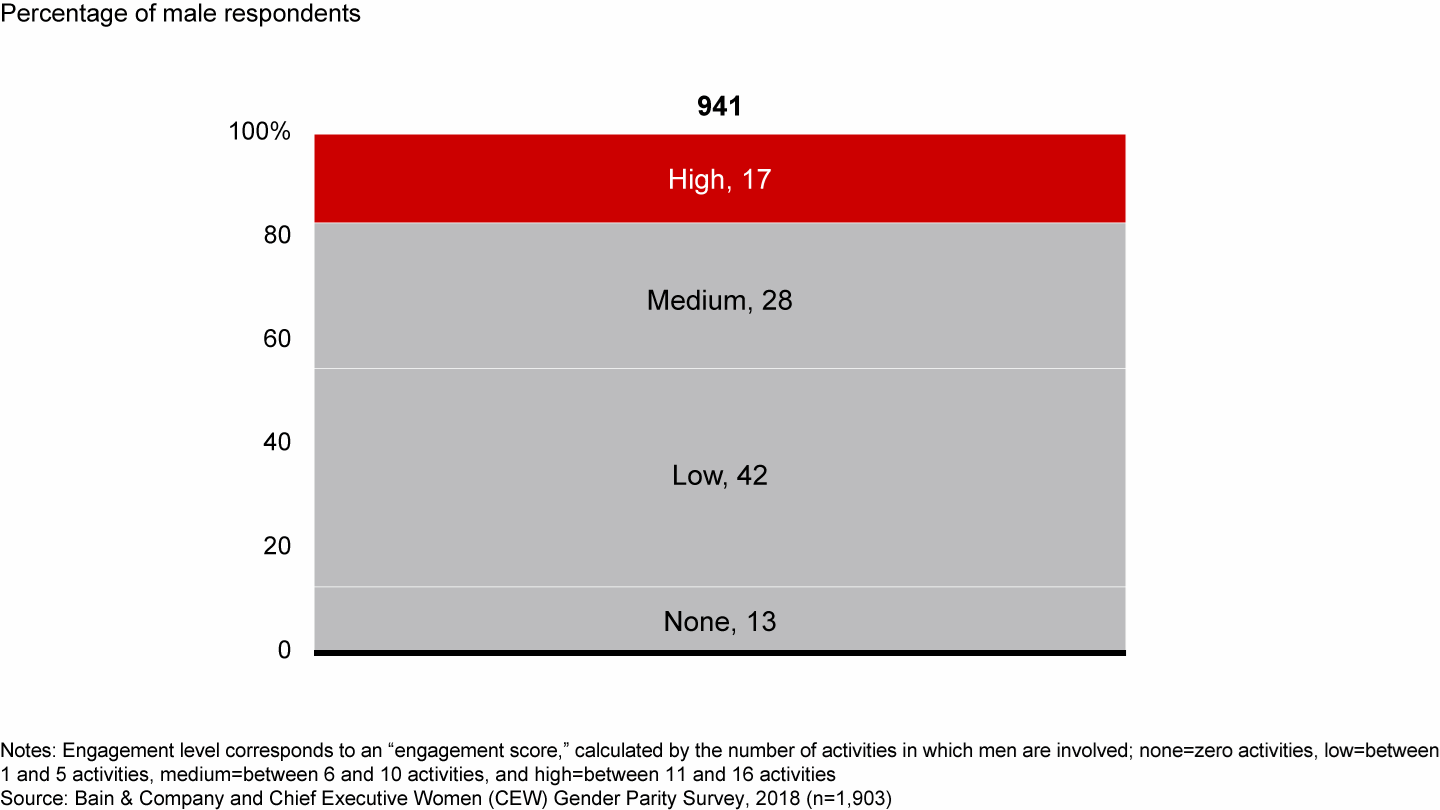
Across our sample, four factors that correlated to higher levels of male engagement stood out: seniority in the organisation, age, exposure to female role models and fatherhood (see Figure 3).
Four factors contribute to higher male engagement
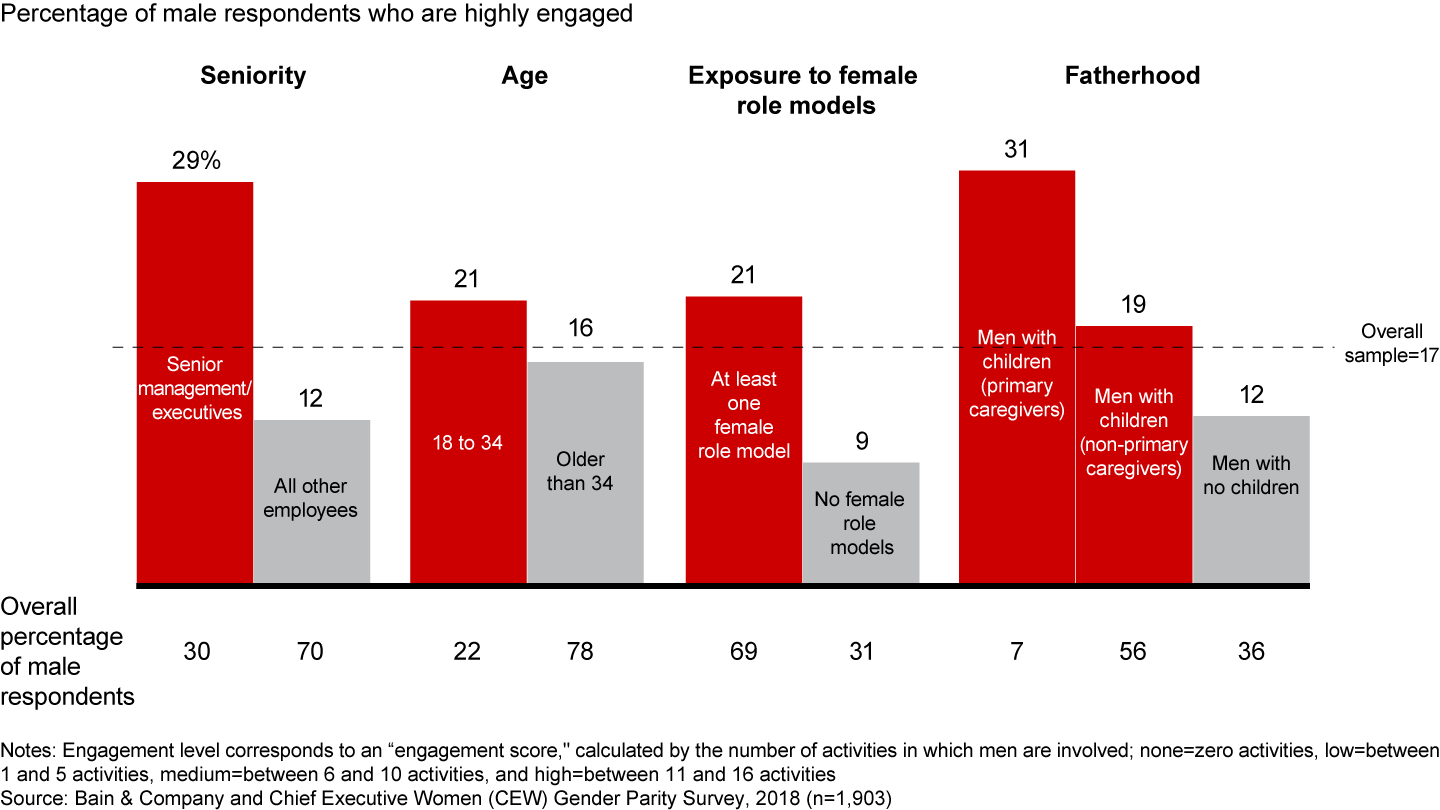
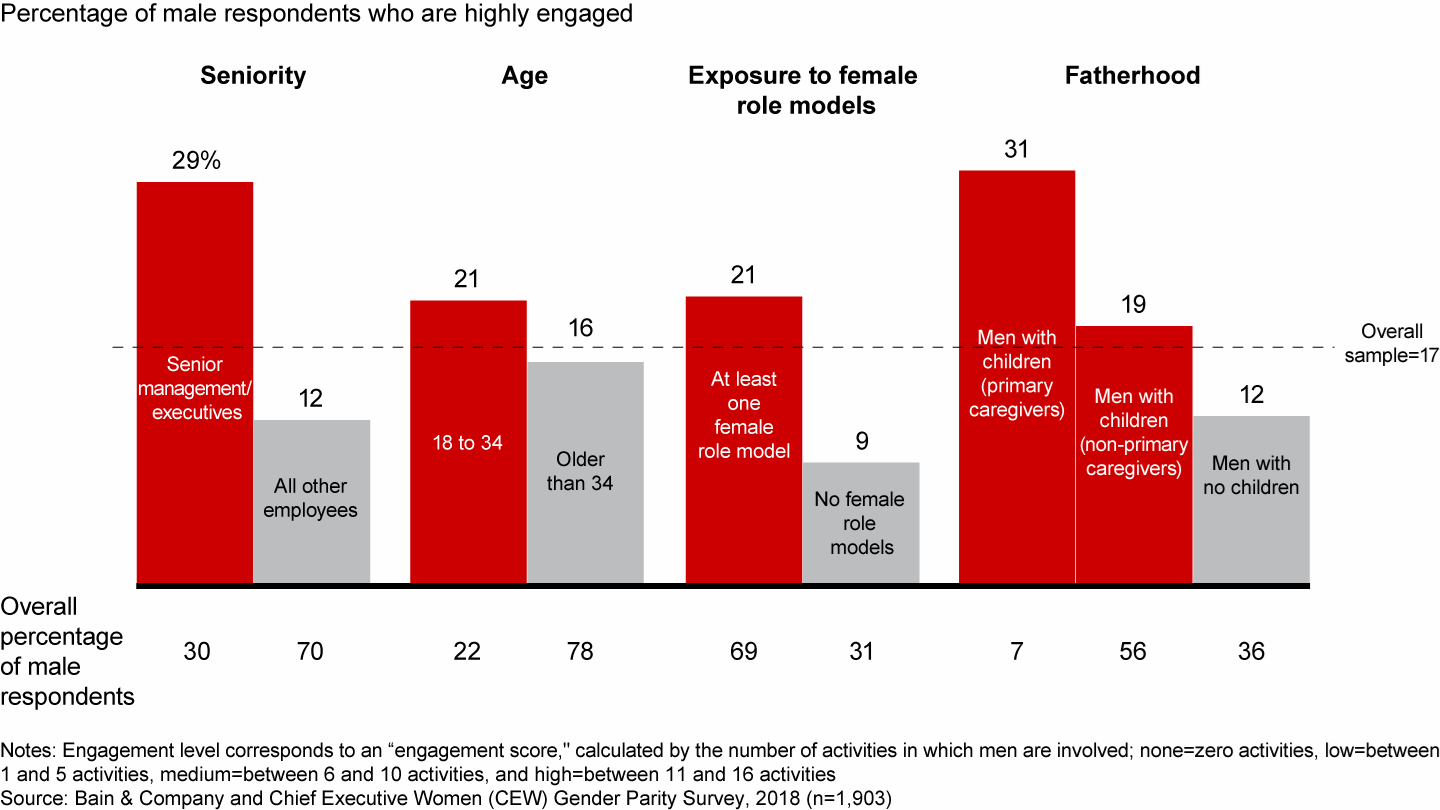
Senior leaders are nearly two and a half times more likely to be highly engaged than other employees. This is encouraging, as visible and committed leadership is a critical factor in creating equal opportunities in the workplace (see the Bain Brief “Actions Speak Louder than Words: CEO Conduct that Counts”). While it’s possible that some men are only leading gender diversity initiatives due to their positions, another explanation is that senior executive leaders participate because they’re exposed to two growing issues. One is the challenge to acquire and retain top talent, which requires tapping into and supporting diverse talent pools. The other is the search for competitive advantage. Research has proven that diverse teams tend to outperform homogenous groups.
Men younger than the age of 34 also reported higher levels of engagement than their older counterparts. This is promising. As those younger men become more senior, they can model inclusive behaviours for the next generations. Having been exposed to more gender-balanced and diversity-conscious environments, younger men see gender parity as a two-way street—that is, it addresses their needs as well as women’s. They understand that workplace programmes that have been historically reserved (or marketed) for women, such as flexible work options and caregiver leave, benefit them as well, and there is evidence to support that. As an example, we know that in Sweden, a mother’s future income increases by 7% for every month in which her husband takes a primary caregiver role. Also, around 90% of Swedish fathers stay at home with their newborn children for three months, which, in the end, benefits both men and women.
Men with female role models, either at work or at home, were more than twice as likely to be highly engaged compared with those who had none. Finally, fatherhood and caregiver status also correlated to higher engagement. Fathers were nearly twice as likely to be highly engaged vs. men with no children. And men who had fulfilled a primary caregiver role at any point in their careers were almost three times more likely to participate in gender parity programmes or initiatives.
We also investigated other factors such as ethnicity, sexual orientation and partner employment status to test whether or not they affected engagement. None of these factors had a strong relationship to high or low engagement in gender equality.
Despite these encouraging signs, opinions and perceptions about men’s engagement vary between men and women. Both genders perceive the status of male engagement nearly identically, but then opinions diverge (see Figure 4).
Men and women perceive men’s engagement in gender equality similarly
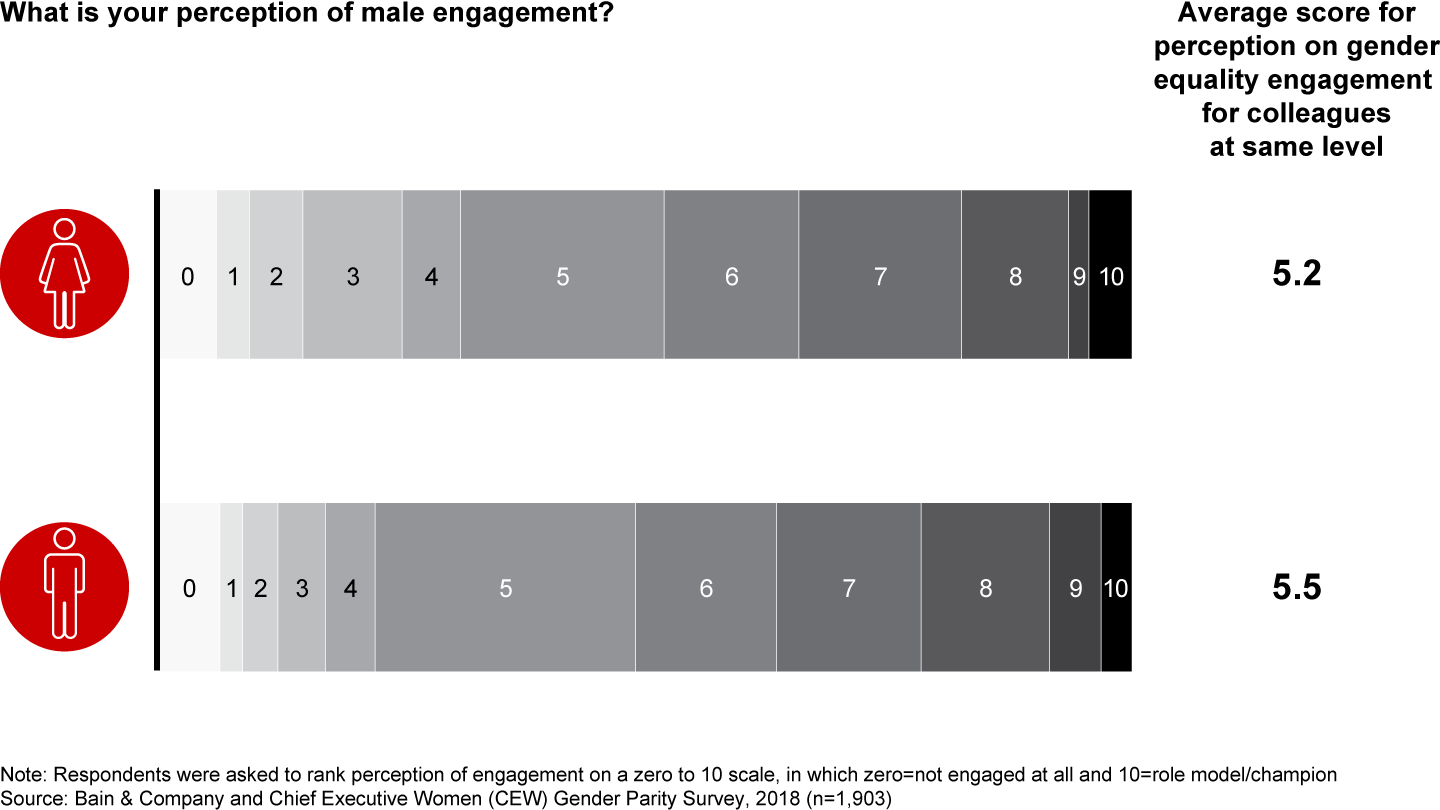
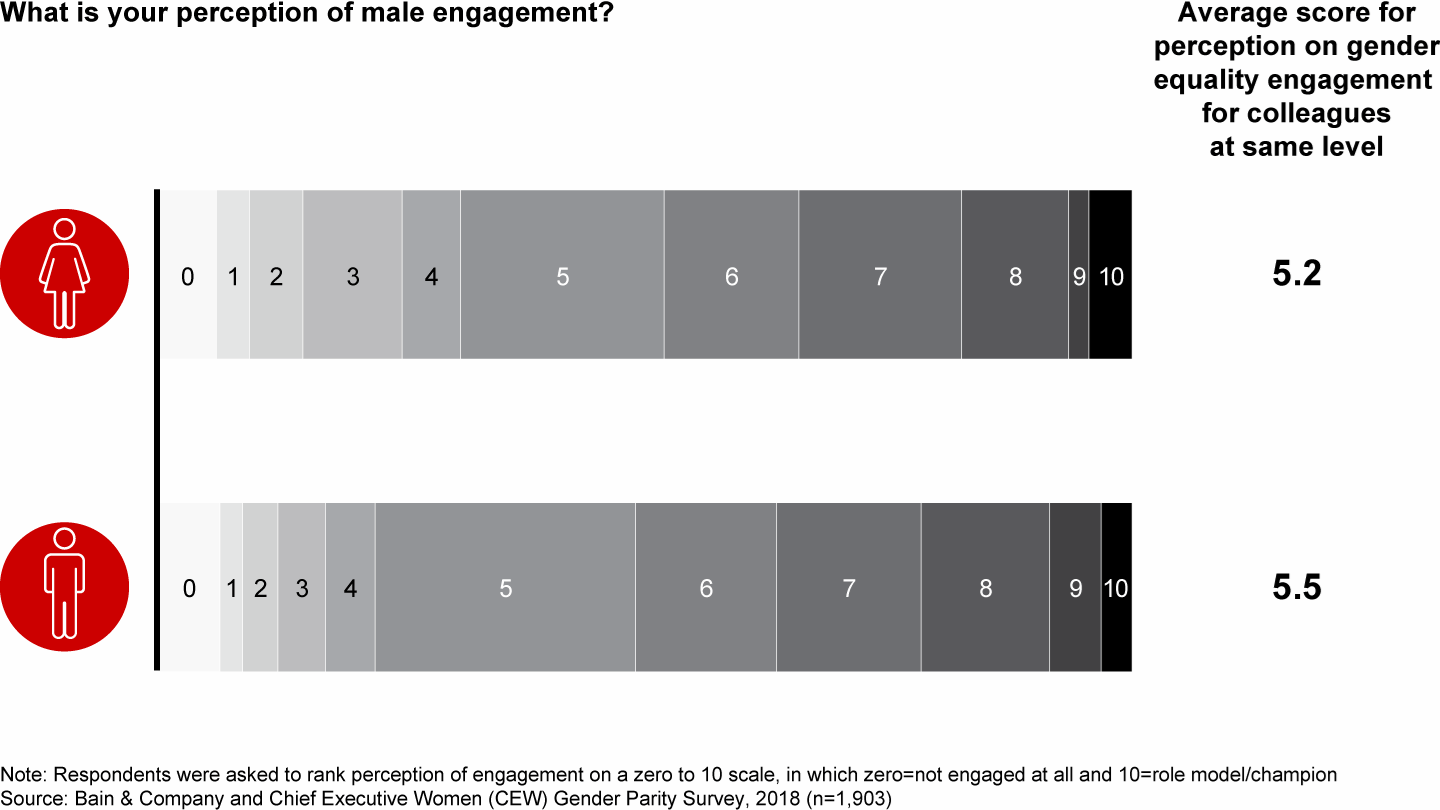
While a large proportion of male respondents (64%) feel satisfied with their current level of engagement, women do not. Almost 70% of women said that they would like men to be more involved (see Figure 5). This points to a fundamental disconnect on how men and women view the topic, and it also puts progress at risk. If both sides don’t understand or recognise the counterview, a dangerous cycle could ensue, in which women demand more participation, causing men to disengage or retract their support. In this scenario, progress stalls as criticism and frustration mount on both sides.
Women want men to engage more in gender diversity
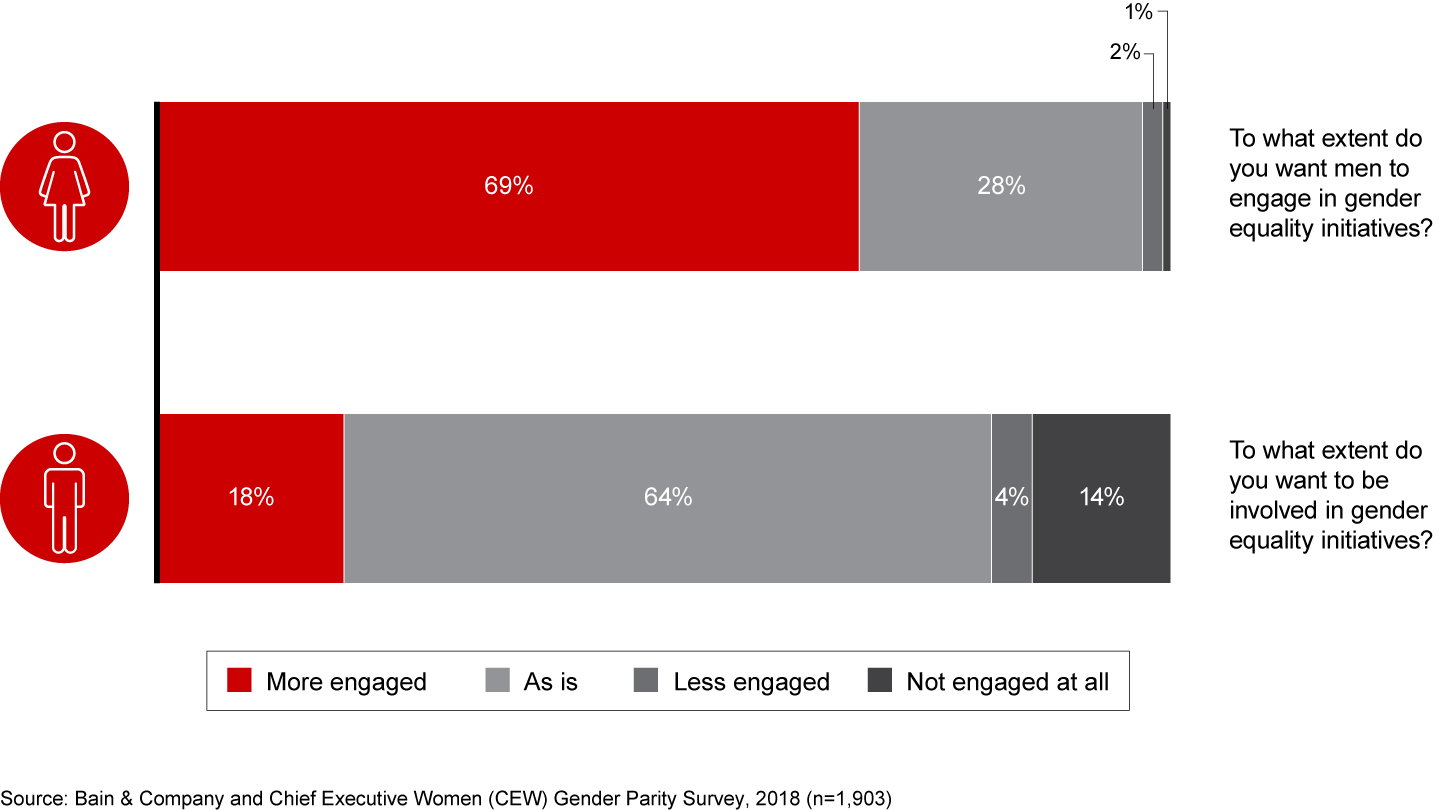
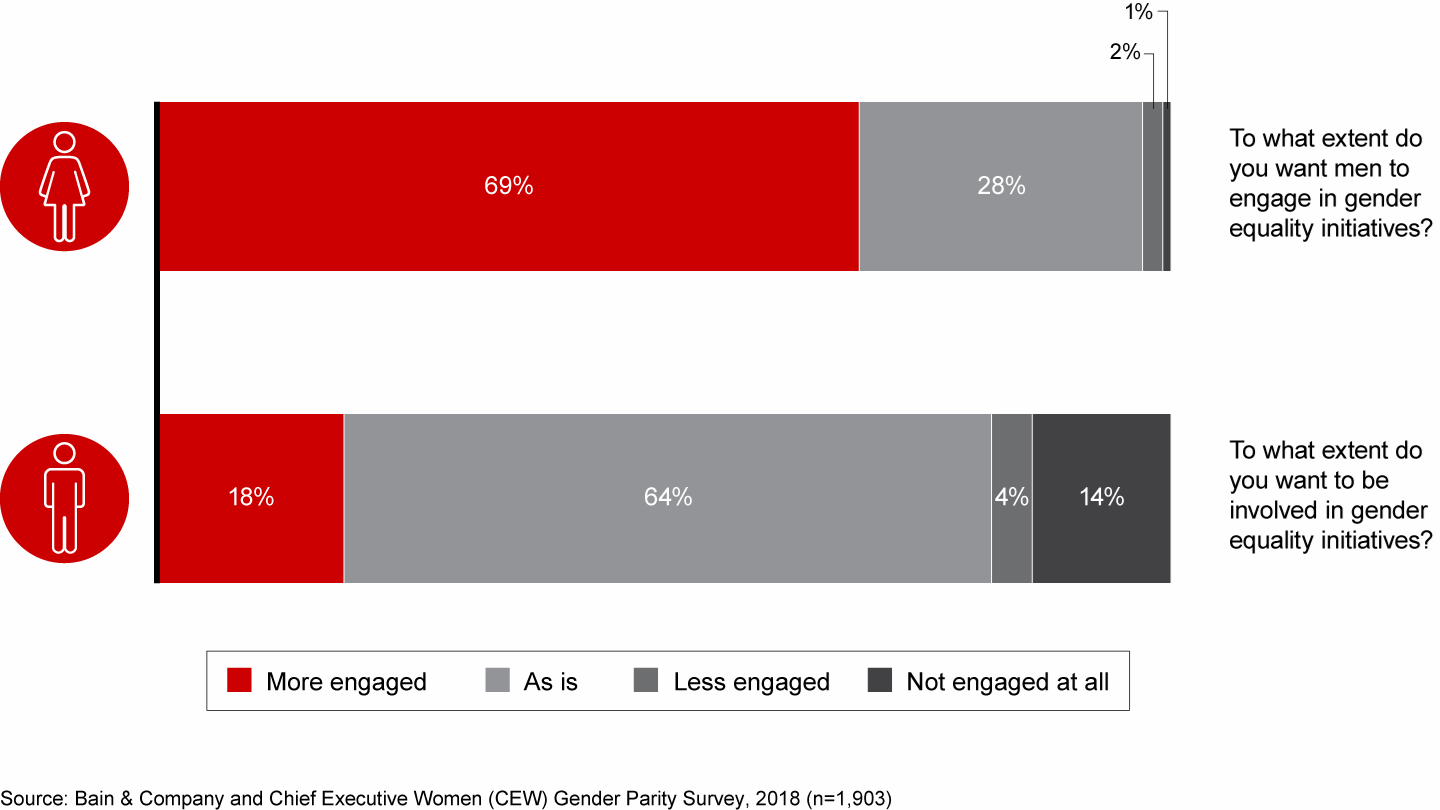
Men and women value gender parity activities differently, too (see Figure 6). Men generally aren’t participating in initiatives that women believe are most likely to advance equality. For example, women believe the most effective actions for men are calling out instances of gender discrimination, sharing household chores and removing bias from people processes. Men rank these activities low in terms of importance (14, 10 and 12, respectively, out of 16 possible actions).
From men’s perspective, the most important steps toward parity are engaging in gender equality conversations with other men, receiving gender bias training and leading a gender diversity group. But interestingly, men aren’t always participating in activities they themselves think are most important either. Men actively engaged in only one activity they ranked as “most important” (and one activity that women ranked highly). Men also reported mentoring female friends and colleagues, which neither gender ranked among the most important actions.
One explanation is that men are participating in the most readily available activities, though they may not be considered the most important. This points to a need for more high-quality and effective options available for men to engage through.
Men and women value gender parity activities differently
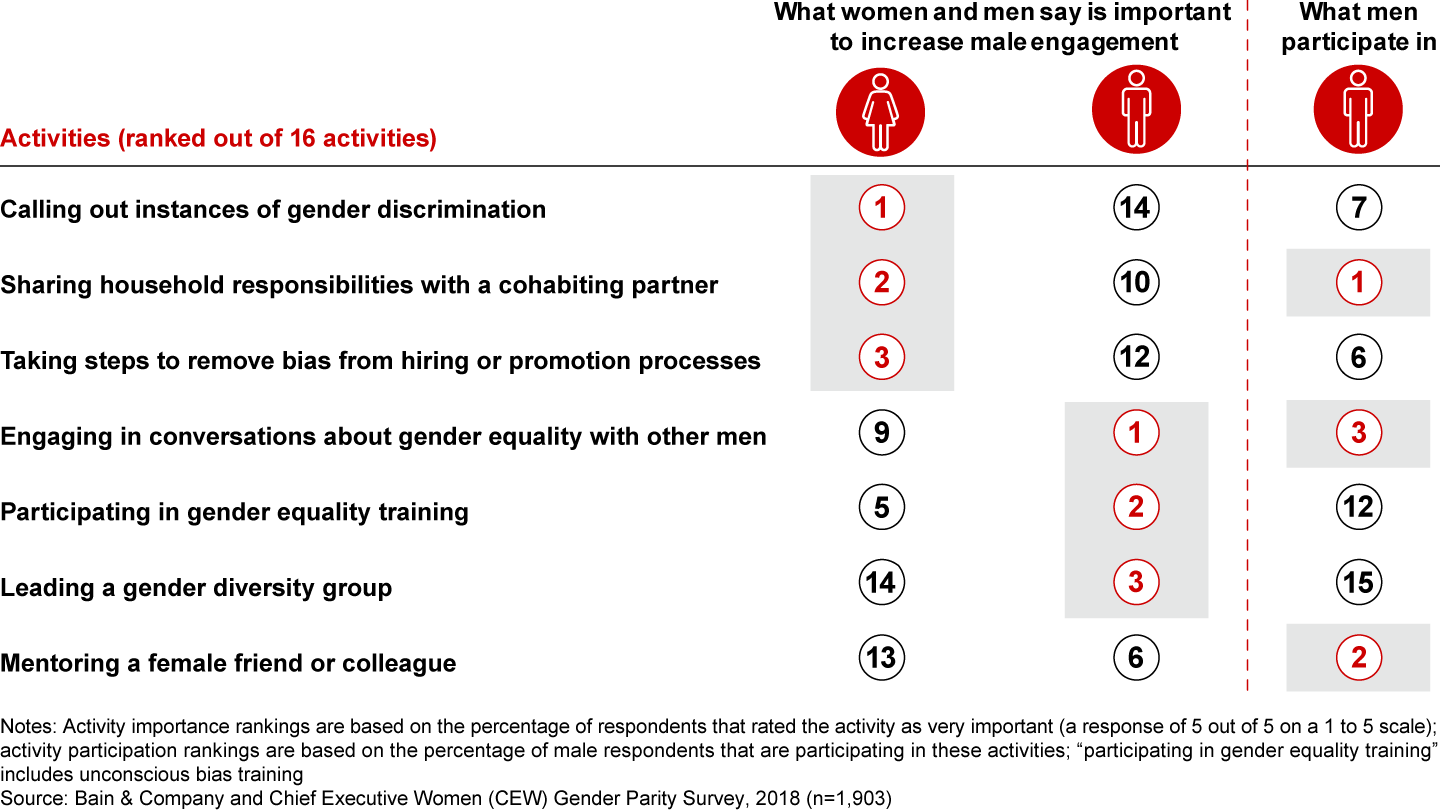
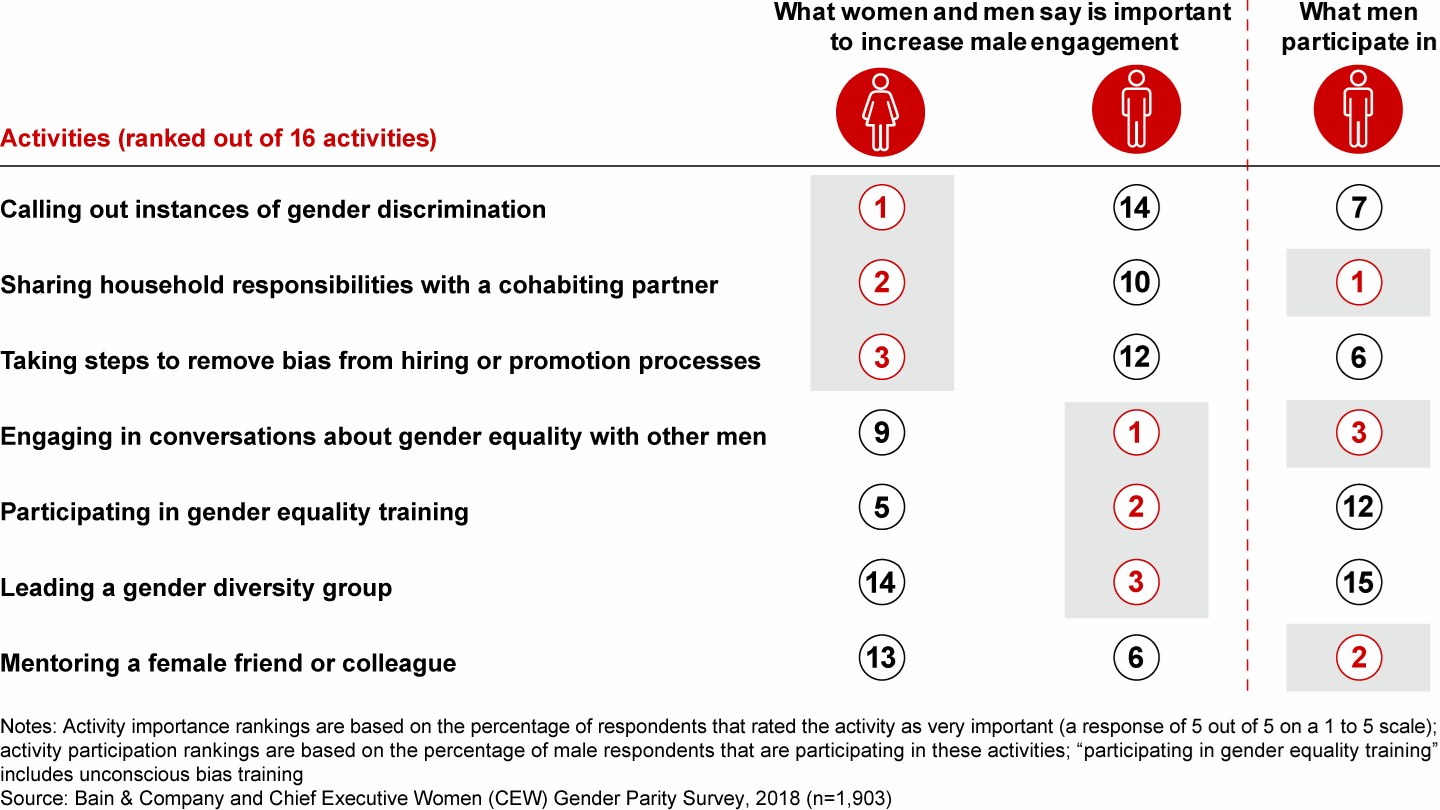
The barriers to engage
All men were asked to identify factors that would either limit or encourage their additional participation. Based on their responses, two distinct groups of men emerged: supporters and passives.
Supporters represent 76% of our sample. These men are already highly engaged or want to maintain or increase their engagement. The other 24%, the passives, want to minimise or stop their engagement. Both groups are integral if we’re to accelerate gender balance, so it’s important to understand their respective deterrents and motivations.
Supporters and passives share two barriers: lack of time and competing priorities. But the similarities stop there (see Figure 7).
Barriers to male engagement vary between two main groups
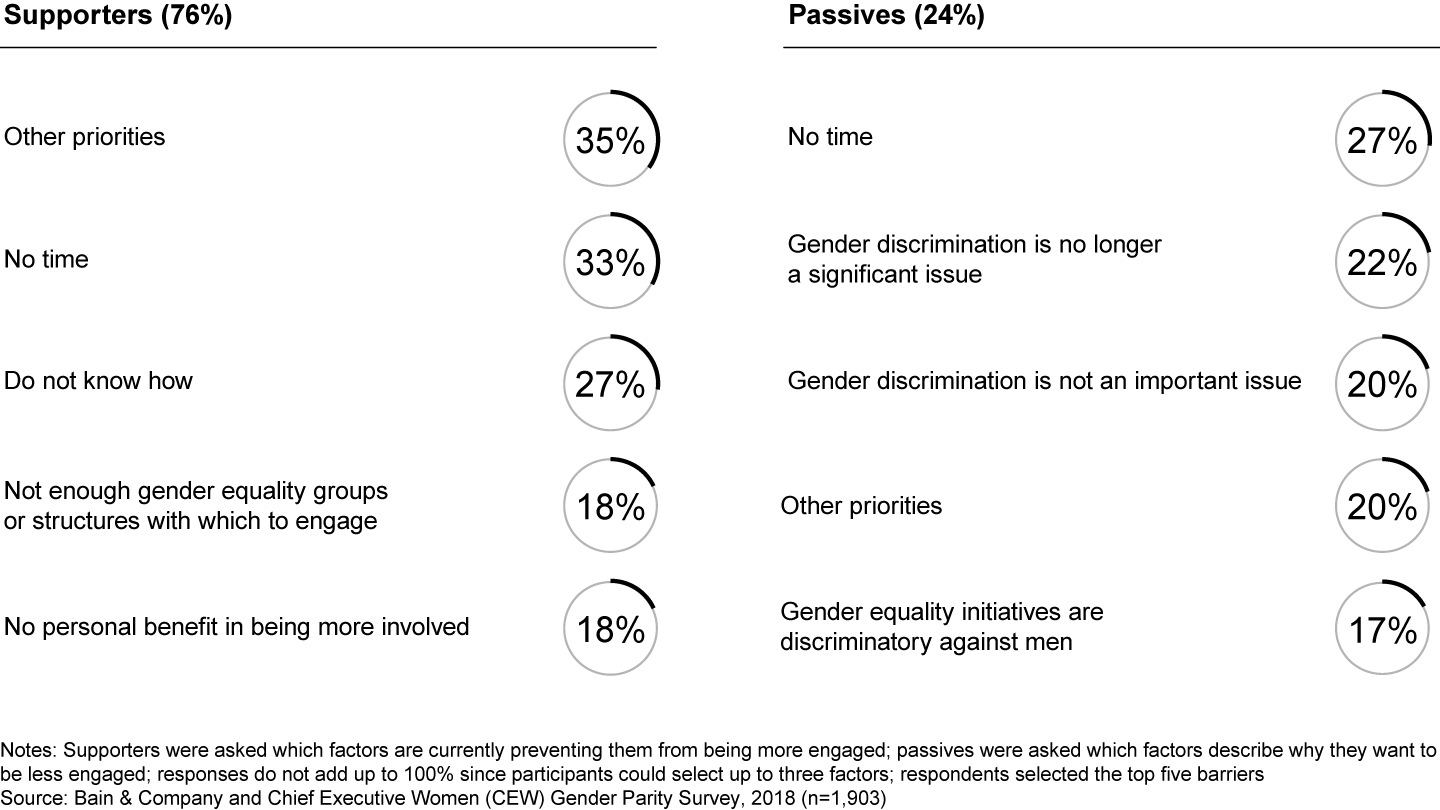
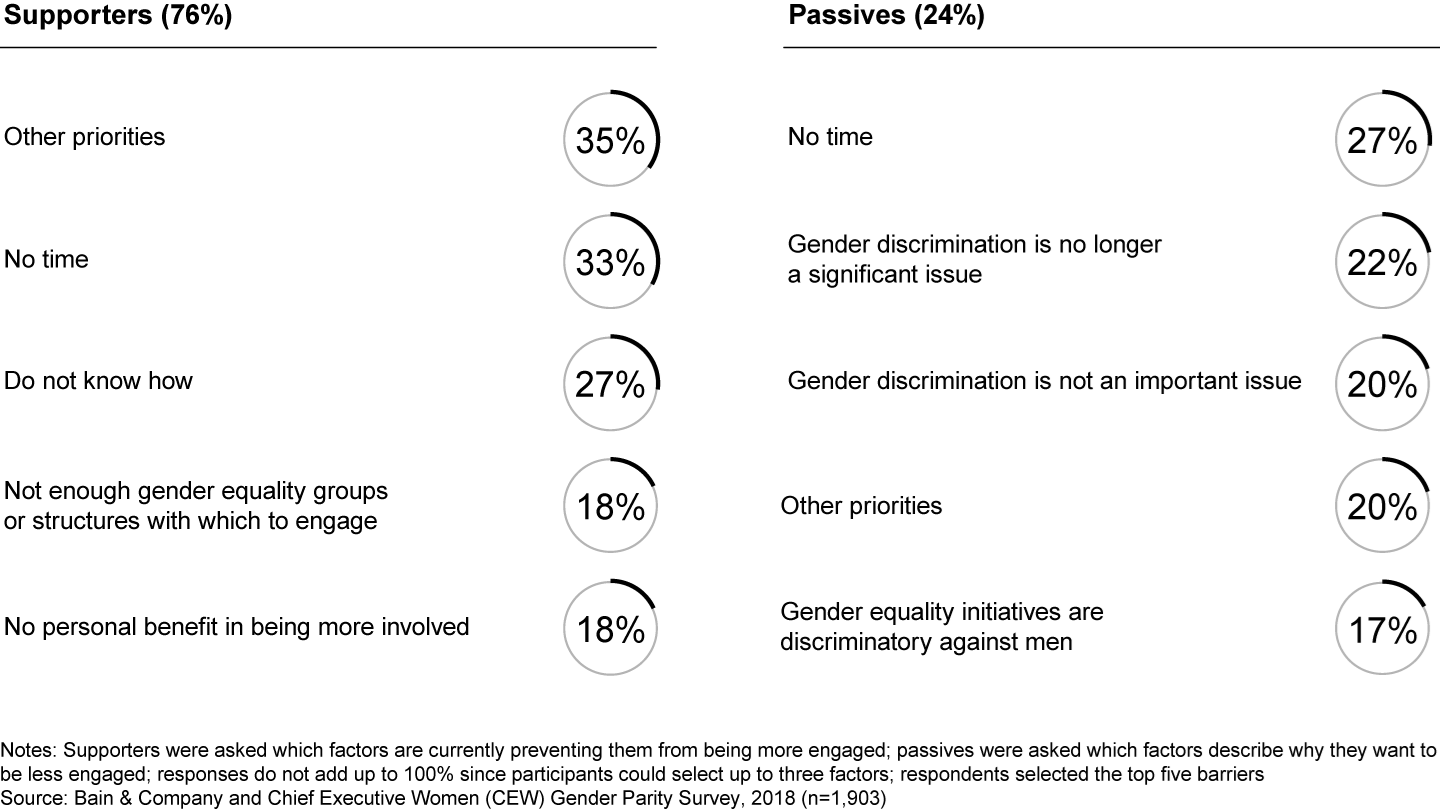
Most importantly, passives don’t see discrimination as a significant problem, or they believe that it’s no longer an issue. In their view, there’s no problem to solve, so why should they get involved? In a respondent’s words: “Gender inequality has long ago ceased to exist in my workplace and most others.” Their low engagement makes sense in that light, but this attitude highlights a fundamental discrepancy in how people understand the issue.
Only a small number of men thought that gender equality initiatives would cause discrimination against men (17% of passives, 4% of all male respondents). While fractional, it’s important to recognise this perception and the factors that lead to this viewpoint (for example, lack of understanding).
Gender equality efforts are sometimes called out as not being fair. One respondent voiced support for gender equality but said that “much of the gender equality debate and initiatives appear to be advancing the causes of women whilst discriminating against men.” His view was that, rather than achieve equality, parity efforts would simply reverse the relationship and widen the gender divide. It’s understandable that backlash or negative reactions exist among men with this point of view. Their concerns need to be addressed in a constructive and fact-based way (see “Understanding backlash”).
-
Understanding backlash (click to expand)
Backlash is an adverse reaction to social or political shifts. Recently, there’s been backlash to gender equality because of the view that emphasising parity initiatives and promoting women into leadership roles is not based on merit and therefore unjust. This perception and attitude can occur at all levels of an organisation and from both men and women.
Passives’ attitudes about engagement shouldn’t be extrapolated across all males. That could be dangerous and create unwarranted tension when, in fact, most men want to be involved.
Aside from the busyness of careers and life, male supporters say that three factors limit their engagement: Not knowing how to engage on the issue is most important; followed by lack of access to the right forums; and not seeing the personal benefits of engaging.
Nearly 30% of supporters aren’t sure how to engage in gender equality, despite their willingness and desire to help. One respondent said, “I’m keen to be involved further but am not entirely sure what I could/should be doing that would actually be useful or appreciated.”
Another respondent wasn’t aware of gender equality initiatives in his workplace, and others commented on being starved for time. “It is something I support wholeheartedly,” one respondent said, “but I have a hard enough time keeping up with the work I get paid for, let alone participating as an active advocate for gender equality.” The same respondent pointed out that many parity programmes require time away from work.
In general, male respondents (both supporters and passives) also struggled to see how gender equality would improve their personal or professional lives. One respondent stated it plainly: “I just don’t think about the topic because gender equality doesn’t affect me.”
Half of the men surveyed agreed their organisation would benefit from greater gender diversity, but more men (60%) thought that their female friends and relatives would be the ones to benefit strongly (see Figure 8). This is despite growing evidence that gender diversity advances business metrics and benefits all employees—and the economy—not just women.
The majority of men see that gender equality benefits their female friends and relatives
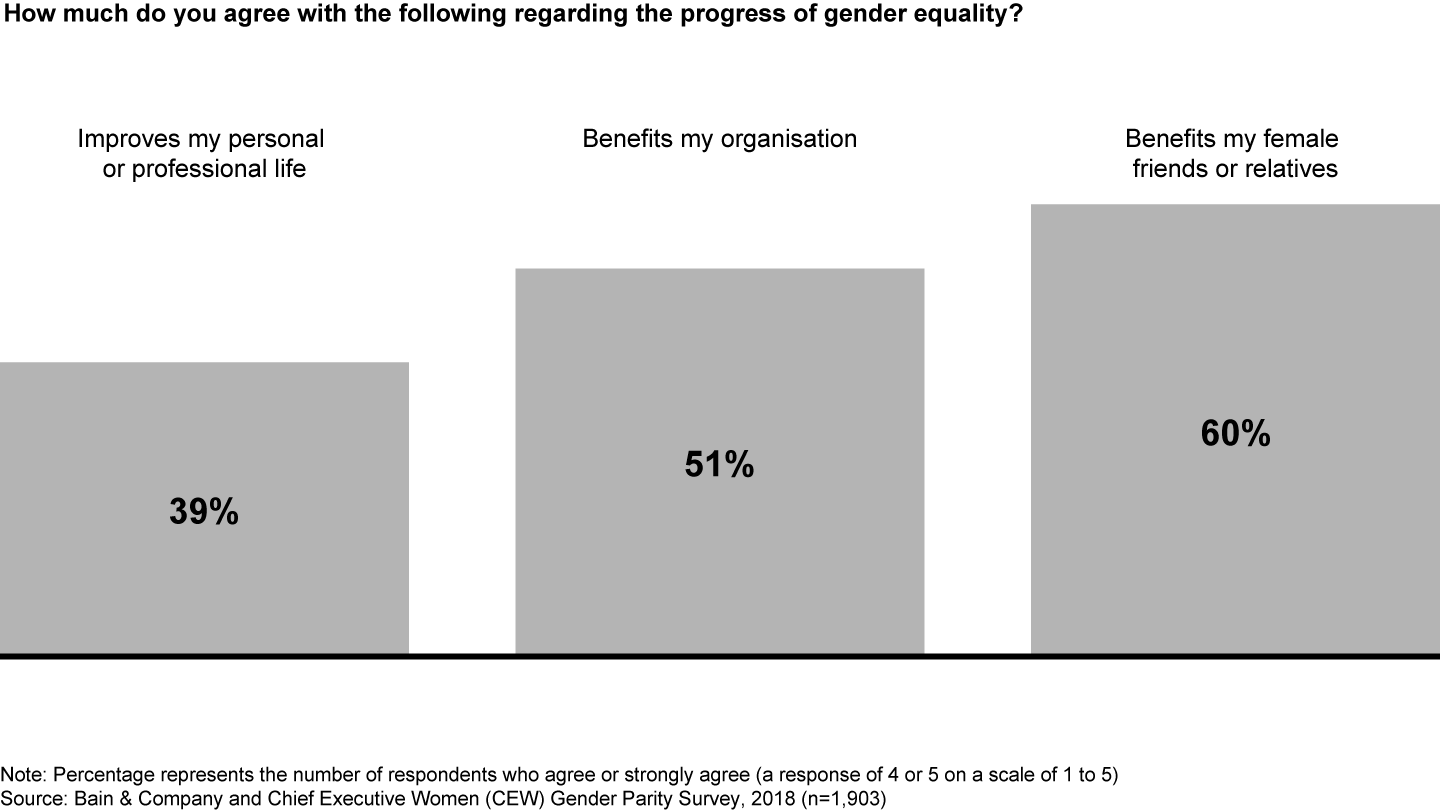
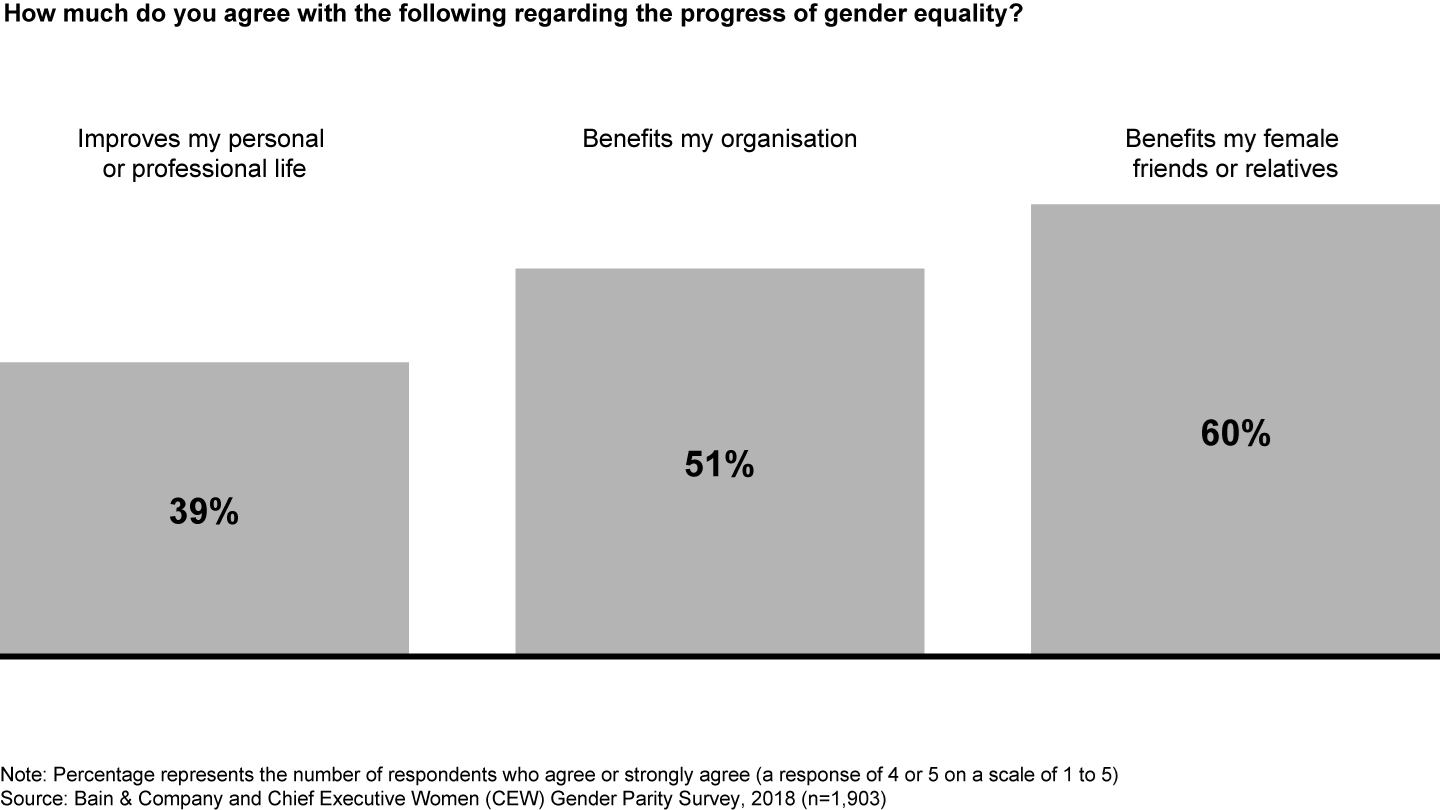
Increasing male engagement
With this understanding, organisations and individuals can tackle the barriers (both perceived and actual) and increase the motivators to male engagement in gender balance efforts. Five specific themes can increase male engagement on gender equality issues:
- leadership commitment;
- continuous communication;
- more inclusive inclusion and diversity programmes;
- making it personal; and
- better, not just more, engagement.
Leadership commitment
Visible and commited leadership is necessary to create equal opportunities and overcome barriers to gender equality (see the Bain Brief “What Stops Women from Reaching the Top? Confronting the Tough Issues”). Leaders must be invested in the cause, articulate the need for change and model actions that progress gender equity.
Two specific actions support this theme.
Action No. 1: Make diversity an explicit, strategic priority. In our survey, respondents reported “a lack of leadership [on the issue] from the top,” and others said that “it is not a requirement mandated by senior leadership.”
Executives and board members should connect gender equality to their purpose and core values and design explicit programmes in their strategy to achieve parity that are tied to the business value it creates. Once established, the leadership team’s commitment to gender parity must be understood, shared and supported by managers, all the way down the line.
Action No. 2: Walk the talk. There is no substitute for leading by example, and men, in particular, must model the way. As one respondent said, “A key roadblock is a lack of senior and executive leadership openly addressing diversity issues.” To make progress, programmes and conversations must be perceived as genuine, rather than token, and they must be part of the daily dialogue.
Leaders have the potential to influence culture and behaviour that are in favour of inclusion within their organisations with actions such as:
- wholeheartedly championing gender equality programmes;
- ensuring that appointments to their teams are gender balanced;
- leading tough conversations;
- taking paternity or caregiver leave; and
- openly leaving early to pick up kids from day care or to attend to other personal business.
Bain Partner Chio Verastegui identifies five themes that can spur action in organizations and individuals, making the gender equality movement more gender equal itself.
Continuous communication
About 20% of passives believe that discrimination no longer exists or isn’t important. Meanwhile, women rarely reach leadership positions compared with men. Continuous education is needed at various levels to illustrate where and how the issue persists. Communication about gender equality should demonstrate how parity benefits more than just women. It should also share learnings and celebrate organisational successes that result from equality.
Leaders can take two actions toward an ongoing gender equality dialogue.
Action No. 1: State the case for change in business terms. Report benchmarks, goals and tactics for achieving gender parity organisation-wide, just as you would any other strategic priority. Determine where your organisation stands in terms of gender parity, set a time-bound goal and then communicate progress across the organisation.
Leverage results in your discussions about gender inclusion, and emphasise how gender equality positively impacts overall economic performance. Make it real rather than relying on conceptual or research-based benefits alone.
Action No. 2: Measure and celebrate progress. It’s important to monitor organisational performance in gender equality. Backed by data, leaders can take actions to advance progress. Additionally, they can connect (and celebrate) the relationship between gender equality initiatives and key performance indicators.
BHP, the world’s largest mining group, is one example. At BHP, its most diverse and inclusive teams exceeded the company’s average on a range of performance metrics. Such outcomes draw a strong connection between parity and performance, and they bolster the company’s plans to increase the number of women in its workforce from 17% to 50%.
More inclusive inclusion and diversity programmes
Historically, inclusion and diversity (I&D) programmes have been targeted more toward women and other minority groups. Focusing too keenly on women is risky, since men may perceive the efforts as exclusive rather than inclusive. One survey respondent said, “Men are not invited to participate,” and described initiatives as “focused on fixing women rather than making it an inclusive cause.”
Meanwhile, men are more apt to engage when they realise benefits, too. Parental leave is one programme in particular in which men have shown interest (see the Bain Brief “The Power of Flexibility: A Key Enabler to Boost Gender Parity and Employee Engagement”).
Programmes to support women, such as coaching and sponsorship, should continue, but we believe that there is opportunity to make them more gender balanced and hence attract more male support. Three actions can make I&D programmes more inclusive and thus increase male engagment.
Action No. 1: Ask men to help design inclusive programmes. Regardless of their engagement level, men said that women-only workplace initiatives decreased their desire to engage or “turned them away.”
If men have an active role in defining, rolling out and marketing programmes, they may be more likely to engage in gender equality activities. In Australia, Bain & Company introduced Manbassadors to complement its traditional, women-only platform called Women at Bain. The new programme created a forum for men to engage in gender equality discussions and addressed the potential backlash of having women-only workplace events (see “Manbassadors at Bain & Company”).
When men do participate, their efforts should be recognised. One respondent said, “I strongly believe we need to celebrate men, too. I think they feel left out of the conversation.”
-
Manbassadors at Bain & Company (click to expand)
The Manbassador programme is aimed at engaging men to take an active and recognised role in the pursuit of gender equality within the Bain Australia community (and more broadly). The role of Manbassadors is twofold: first, to actively support women in fulfilling their potential by sponsoring female colleagues and modelling inclusive work environments; and second, to collaborate in solving diversity-related issues by bringing another point of view. When the programme was piloted, the response was overwhelming. Many more men volunteered to join than the original allocated slots. In the words of one participant: “The Manbassador programme was the first real formal opportunity that was offered to me to be a part of the solution. I have always been passionate about gender equality, but before being a Manbassador, I didn’t know what I could do, especially as a relatively junior person in the firm.”
Action No. 2: Make flexible working options available and acceptable to everyone. Half of men said flexible work and parental leave options would encourage them to engage in gender equality issues. That’s because support programmes help all employees—not just women. Workers across every demographic face an increasing need to balance caregiving and other personal demands with workplace priorities.
Most workers feel flexible working isn’t supported, though. While more men are enthusiastic about flexible working models, they don’t necessarily adopt them because they believe flex work will hurt their career progression or reputation (see the Bain Brief “The Power of Flexibility: A Key Enabler to Boost Gender Parity and Employee Engagement”). If flexible working programmes are to be effective, leadership teams need to encourage, model and celebrate their adoption.
Action No. 3: Create a safe and trusting environment. Men and women view the world differently. While that’s one benefit to gender (and overall) diversity in the workplace, it’s a potentially contentious starting point for discussing and addressing gender equality.
Both men and women recognise this barrier. One female respondent perceived that “a lot of men want to be engaged and involved in equality initiatives; however, they don't know how to discuss such topics without worrying about offending or saying the wrong thing.” Another respondent said that “uncertainty makes it easier to de-prioritise gender equality over other competing demands on their time.”
Men and women must be able to discuss the topic openly; otherwise, initiatives will fail, and progress will stagnate. Half of our male respondents said an atmosphere of trust would encourage greater participation in gender equality.
For gender parity forums to be successful, men and women must presume a position of trust and goodwill. All points of view need to be shared safely and heard openly—and without fear of attack or reprisal. Progress requires ongoing dialogue and joint action.
I&D leaders are best positioned to coordinate such forums alongside line managers so that they can establish rules of engagement and facilitate tough conversations. Line management must ultimately be responsible for following through, similar to other corporate transformations, such as the safety journeys that most oil and gas companies have undertaken.
Making it personal
Right now, men think that equality will benefit their female friends or colleagues far more than it will advance their own personal or professional lives. To increase male engagement, there needs to be a stronger connection between gender parity and the benefits that men experience as a result.
Two actions can be taken.
Action No. 1: Create opportunities for high-potential men to work with female role models. Men with female role models at home or at work are more likely to be highly engaged in equality issues than those without (21% vs. 9%, respectively). Linking high-potential men to female leaders can have a strong and long-lasting impact on male engagement, particularly if these men remain highly engaged as they advance into more senior and influential positions.
We recognise that this may be difficult to enact given the small percentage of females in leadership and C-suite positions, but that should not deter the effort across other levels of the business. A simple female-male buddy system among peers could be a starting point toward building equitable relationships and gaining a greater understanding of each other’s positions.
Action No. 2: Women, personally invite men to become more engaged in gender equality programmes. Both men and women cited “not knowing how” as one of the top three reasons why men don’t engage on gender equality. One simple mitigation is for women—and leaders—to simply ask men to participate. In our sample, men were more receptive to personal appeals from friends, colleagues and family members than formal direction or imposed programmes. In fact, 52% of male respondents said being asked by female colleagues to participate was one of the top ways to increase their involvement.
Better, not just more, engagement
About a third of supporters said that a lack of time or other priorites kept them from being more engaged. The notion that men don’t have time to engage on gender equality issues assumes that men have to do something extra to support women. We propose that organisations and individuals alter their current actions rather than add to them. Leaders and I&D teams should make it as easy as possible to do the right thing by standardising processes and systems that support equality.
Two actions can affect gender equality without additional effort on the part of men.
Action No. 1: Modify people processes to be inclusive. Many of the processes that have to be done anyway can be adapted to promote equity. For example, unconscious biases may be holding women back at various stages of the talent life cycle, such as promotion or project assignment processes. At key decision points, systematic mitigations can be embedded to counteract bias. For example, organisations are incorporating artificial intelligence to automate parts of the hiring process and help them remove unconscious gender biases. As a result, companies can make more objective and data-driven decisions while saving time and resources.
Similarly, men who are already sponsoring employees can deliberately include a woman on their team. Their time commitment would be the same, but the activity would have greater value in terms of gender parity. In general, women have been shown to be undersponsored compared with their male peers—and without sponsorship, women are less likely than men to be appointed to top roles (see “The difference between a mentor and a sponsor”).
Action No. 2: Prioritise the most valuable activities. Currently, male activity is not aligned with what drives gender equality, as ranked by women or men. Using data and candid input, I&D leaders and executives can help men understand the menu of options and which activities matter most. Companywide, I&D efforts should focus on activities that are most influential, such as removing bias from organisational processes or calling out instances of gender inequality.
-
The difference between a mentor and a sponsor (click to expand)
Mentors are advisers who can offer perspective on your role, career and situation. They empathise with your situation and offer suggestions on how to play to your strengths. Mentors expect very little in return for their advice and support.
Sponsors are individuals of influence who advocate for others to ensure that they are considered for relevant roles or opportunities. They give concrete opportunities, rather than advice, and can use their power to influence your career journey. Sponsorship can occur in addition to mentorship, but it is more effective than merely having a professional sounding board.
What’s next?
Gender parity has evolved from a social concept to a business asset. Backed by measurable and replicable benefits, organisations globally are striving for greater gender balance. In corporate Australia, progress is slow, but the conditions are favourable: Male supporters of gender parity are in the majority, and men across all ages and ranks have voiced their commitment to advancing women in the workforce.
To effect change, gender parity must be approached on two fronts: the moral imperative and the business case.
The Australian public expects better corporate citizenship. Younger generations demand it, as they pursue employers and opportunities that align with their purpose and values. Beyond being the right thing to do, parity can also advance business outcomes for the benefit of all. Business wins earned through equality can create momentum for the issue.
While male engagement is not the only factor keeping corporate Australia from gender parity, it is a critical element. To achieve equality, it must be everyone’s issue, not just a women’s issue. The value must be evident across gender and rank, regardless of industry or geography.
The task, then, is to illuminate the path. Through this research, men described the barriers keeping them from further engagement. In response, we’ve offered five starting points with clear actions to address their concerns and prompt engagement. Next, men and women, companies and individuals, must move forward together to make a difference. This is one business problem that must be solved together.
Years ago, safety was a critical focus area in the mining industry. Over the years, safety has evolved from an issue to an ingrained and essential part of mining companies’ culture, values and behaviours. It’s a front-and-centre priority for everyone in the organisation, and leaders are accountable for hitting high targets.
Together, men and women can resolve this, too. One day, gender equality can be part of all companies’ DNA, values and behaviours, similar to what safety means for mining companies today.
Our methodology
This report is focused on attitudes about gender equality and male engagement in gender equality initiatives in the Australian workplace. Our findings are based on a survey answered by 1,903 professionals in Australia. Respondents were roughly 49% male and 50% female; less than 1% of respondents either did not disclose their gender or designated “other.”
About 10% of respondents were executive- or board-level employees. The balance was composed of senior managers (21%), junior and middle managers (19%), experienced employees (41%) and junior employees (6%); about 3% of respondents did not disclose their rank.
Respondents identified the gender of their CEOs and direct supervisors. They reported their CEOs being 75% male, 19% female, and 6% did not disclose a gender. Their direct supervisors were 61% male, 37% female, and 2% did not disclose a gender.
More than 14 industries were represented in the report, including accounting and finance, the public sector, retail, healthcare, information technology, law, energy, industrial, real estate, telecommunications, consumer, utilities, professional services, education, and materials. About 8% of respondents identified their industry as “other.”
Inclusion score out of 100% is based on agreement with nine equally weighted questions across three categories.
- Role models: “My CEO role models inclusive behaviour.” “My direct supervisor role models inclusive behaviour.”
- Day-to-day experiences: “I feel my ideas are heard and valued.” “I feel free to express my views and opinions in the workplace.” “I can be successful as my authentic self in my organisation.” “I feel comfortable and included at my company’s social or networking events.”
- Organisational norms: “In my work environment, everyone is treated fairly regardless of personal background.” “My company is effective at retaining people with different backgrounds, characteristics and perspectives.” “Inclusion is a central part of my organisation’s values.”
About the authors
Chio Verastegui is a partner with Bain & Company’s Customer Strategy & Marketing and Results Delivery® practices. You may contact her by email at chio.verastegui@bain.com. Freek Jorna is a manager with Bain & Company’s Performance Improvement and Retail practices. You may contact him by email at freek.jorna@bain.com. Chio and Freek are both located in Bain’s Sydney office.
Sue Morphet is president of Chief Executive Women. You may contact her at smorphet@cew.org.au. Jenny Boddington is the chair of Chief Executive Women Business Engagement Committee and member of the board of Chief Executive Women. You may contact her at jboddington@cew.org.au.

About Chief Executive Women
Chief Executive Women’s (CEW’s) almost 1,000 members hold leading roles in Australia’s largest private and public organisations. They oversee more than 1.3 million employees and $749 billion in revenue. Members’ organisations have a combined market capitalisation greater than $1.144 trillion and contribute in excess of $249 billion to Australia’s GDP. Since 1985, CEW has influenced and engaged all levels of Australian business and government to achieve gender balance. Through advocacy, research, targeted programmes, and scholarships, CEW helps remove barriers to women’s progression and ensures equal opportunity for prosperity. CEW’s members work actively to realise our vision of a community where women and men have equal economic and social choices and responsibilities.
-
References (click to expand)
“Australia. Staff Report for the 2017 Article IV Consultation” [IMF Country Report No. 18/44]. International Monetary Fund, Asia and Pacific Department, 23 January 2018.
“Backlash & Buy-In: Responding to the Challenges in Achieving Gender Equality.” Chief Executive Women and Male Champions of Change, 2018.
“The Business Case for Gender Equality.” Australian Government, Workplace Gender Equality Agency, November 2018.
Duvander, Ann-Zofie, and Mats Johansson. “Reforms in the Swedish Parental Leave System and Their Effects on Gender Equality.” Stockholm Research Reports in Demography, 13 (2015).
EMP04: Employment by occupation. Office for National Statistics, 11 September 2018.
EMP13: Employment by industry. Office for National Statistics, 13 November 2018.
“Female Labour Force Participation Reaches All-Time High.” Australian Bureau of Statistics, 21 March 2018.
Flood, Michael, Graeme Russell, Jane O’Leary, and Cathy Brown. “Men Make a Difference: Engaging Men on Gender Equality. Synopsis Report.” Diversity Council Australia, 2017.
Florentine, Sharon. “How Artificial Intelligence Can Eliminate Bias in Hiring.” CIO, 22 December 2016.
Ibarra, Herminia, Nancy M. Carter, and Christine Silva. “Why Men Still Get More Promotions Than Women.” Harvard Business Review, September 2010.
Rock, David, Heidi Grant, and Jacqui Grey. “Diverse Teams Feel Less Comfortable—and That’s Why They Perform Better.” Harvard Business Review, 22 September 2016.
“Senior Executive Census 2018.” Chief Executive Women, September 2018.
Werhane, William, and Mark Royal. “Engaging and Enabling Employees for Company Success.” Hay Group, October 2009.

What stops women from reaching the top? Confronting the tough issues
There are too few women in top leadership positions in Australian companies. Here's why.

Actions Speak Louder than Words: CEO Conduct that Counts
What can CEOs do to create positive and engaging environments for both men and women?

The Power of Flexibility: A Key Enabler to Boost Gender Parity and Employee Engagement
How Australian organisations can create positive flexible workplace conditions for both women and men.